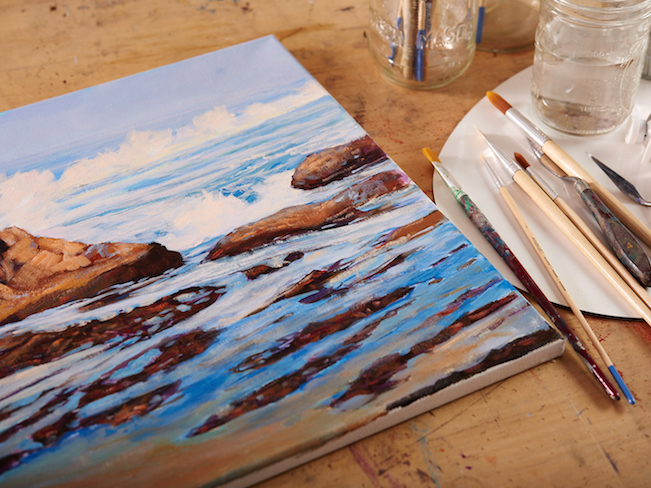
All art by Peter John Reid
Water is endlessly inspiring to artists. There's something deeply compelling about its ever-changing nature, whether in a still, reflective pond or a rushing stream. But water is also one of the most difficult things to paint realistically in acrylic.
Consider these tips to set yourself up for success:
1. Always Work From a Reference
When painting something as variable as water, trying to capture the image in your mind's eye is really hard. Better to paint from life or from a photograph.
2. For Calm Water, Follow the Value Rule for Reflection

In general, the values of an object reflected in the water are more muted than on the object itself. If you are painting a reflection of a tree, the reflection of the dark part of the trunk will be lighter than it is on the trunk itself. The opposite is true for the tree’s highlights.
3. Try Glazing to Lighten Up Calm Water
One technique I turn to a lot is glazing. To begin, I paint the reflection almost the same color as the object. Once it's dry, I take some acrylic glazing liquid and a small amount of white paint, and glaze this mixture smoothly over the reflection. This lightens up the water in a subtle way, giving it a realistic look.
4. Remember That Running Water Is White

Where there's movement in water — a waterfall, waves, rapids — there are no reflections.
Sometimes a water scene can contain both calm and moving water, which calls for some reflections and also some energetic and varied strokes. Be bold with your brushwork.
Ripples are an exception to the rule and usually just distort the reflection in the water, but I suggest studying some photos of ripples before deciding how you want to paint them.
5. Pay Attention To the Land Element

Waterlines, where the water comes up on the land, are light in value and are made up of neutral, earthy colors. A waterline usually does not span the entire shore; it's mostly a broken line with many variations of thick and thin.
Painting in a land component gives you a chance to add other elements, like wildflowers or rocks, that add depth to your painting and make it more realistic.
<!--Learn to Paint Seascapes in Acrylic

Capture the beauty and power of the ocean in vivid acrylic seascapes. Transport viewers to breathtaking coastal shores!

I am self taught and would love to be able to paint glassy water. Thankyou
Glad I found you
Love it, what a great idea for learning from John Reid. Thank you , Judith Leszczak
love Peter John Reid's classes